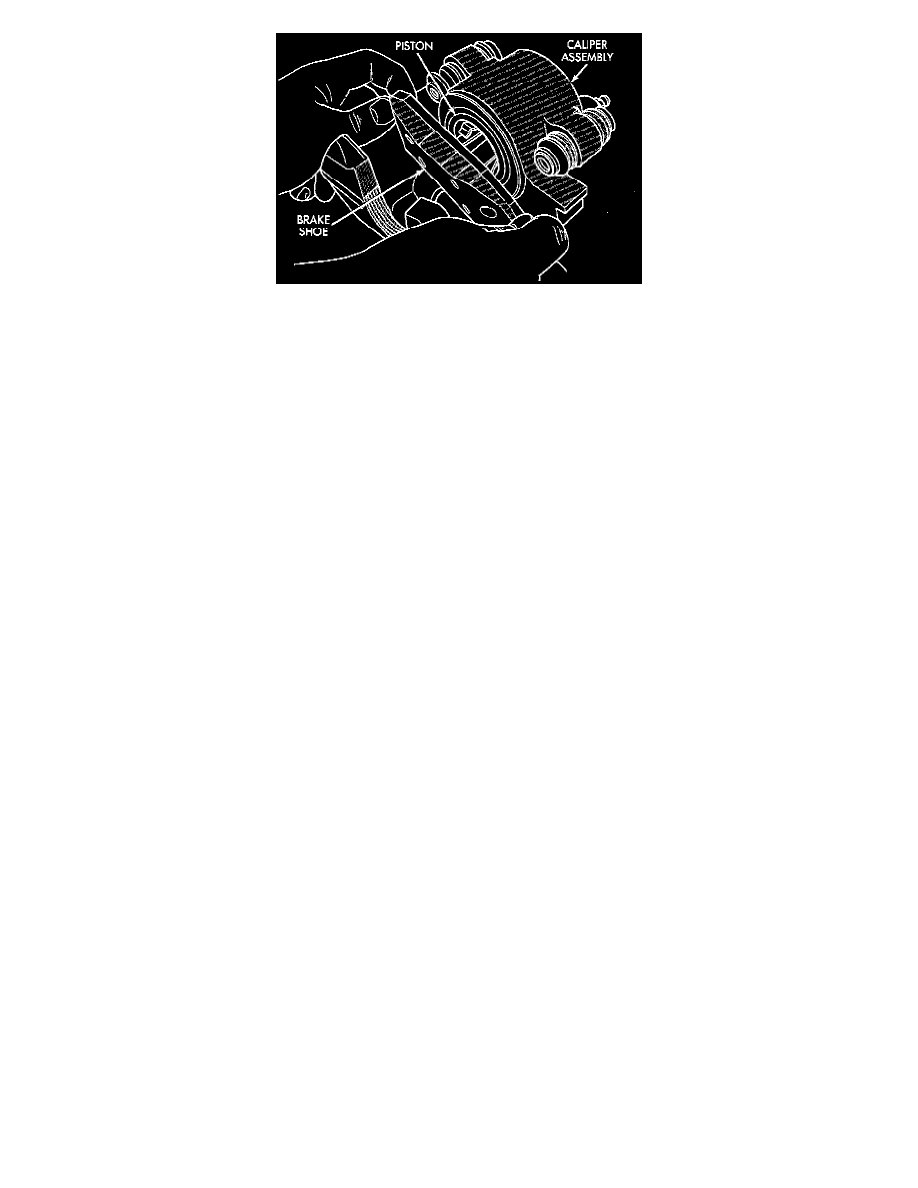Intrepid V6-3.5L VIN V (2002)

Inboard Brake Shoe
7. Pull inboard brake shoe away from piston until retaining clip is free from cavity in piston.
8. Repeat steps 3. through 7. on opposite side of vehicle to remove that sides brake shoes.
REMOVAL - FRONT DISC BRAKE SHOES (EXPORT)
1. Raise vehicle.
2. Remove both front wheel and tire assemblies from vehicle.
3. Remove the two caliper guide pin bolts.
4. Remove caliper assembly from steering knuckle. Proceed by first rotating top of caliper away from steering knuckle and then lifting caliper off
bottom machined abutment on steering knuckle.
5. Hang the caliper off to the side using wire or bungee cord. Do not allow the caliper to be supported by the flexible brake hose. Damage to the
flexible brake hose may result.
6. Remove outboard brake shoe by prying the shoe retaining clip over raised area on caliper. Then slide the brake shoe off the caliper.
7. Pull inboard brake shoe away from piston until retaining clip is free from cavity in piston.
8. Repeat steps 3. through 7. on opposite side of vehicle to remove that sides brake shoes.
CLEANING - DISC BRAKE SHOES
WARNING: DUST AND DIRT ACCUMULATING ON BRAKE PARTS DURING NORMAL USE MAY CONTAIN ASBESTOS FIBERS
FROM PRODUCTION OR AFTERMARKET BRAKE LININGS. BREATHING EXCESSIVE CONCENTRATIONS OF ASBESTOS
FIBERS CAN CAUSE SERIOUS BODILY HARM. EXERCISE CARE WHEN SERVICING BRAKE PARTS. DO NOT SAND OR GRIND
BRAKE LINING UNLESS EQUIPMENT USED IS DESIGNED TO CONTAIN THE DUST RESIDUE. DO NOT CLEAN BRAKE PARTS
WITH COMPRESSED AIR OR BY DRY BRUSHING. CLEANING SHOULD BE DONE BY DAMPENING THE BRAKE
COMPONENTS WITH A FINE MIST OF WATER, THEN WIPING THE BRAKE COMPONENTS CLEAN WITH A DAMPENED
CLOTH. DISPOSE OF CLOTH AND ALL RESIDUE CONTAINING ASBESTOS FIBERS IN AN IMPERMEABLE CONTAINER WITH
THE APPROPRIATE LABEL. FOLLOW PRACTICES PRESCRIBED BY THE OCCUPATIONAL SAFETY AND HEALTH
ADMINISTRATION (OSHA) AND THE ENVIRONMENTAL PROTECTION AGENCY (EPA) FOR THE HANDLING, PROCESSING,
AND DISPOSING OF DUST OR DEBRIS THAT MAY CONTAIN ASBESTOS FIBERS.
INSPECTION - DISC BRAKE SHOES
Visually inspect brake shoes (pads) for uneven lining wear. Also inspect for excessive lining deterioration. Check the clearance between the tips of the
wear indicators on the shoes (if equipped) and the brake rotors. If a visual inspection does not adequately determine the condition of the lining, a
physical check will be necessary. To check the amount of lining wear, remove the disc brake shoes from the calipers. Measure each brake shoe. The
combined brake shoe and its lining material thickness should be measured at its thinnest point.
-
For front disc brake shoes, when a set of brake shoes are worn to a thickness of approximately 7.95 mm (5/16 inch), they should be replaced.
-
For rear disc brake shoes, when a set of brake shoes are worn to a thickness of approximately 7.0 mm (9/32 inch), they should be replaced.
-
Typically, if front shoes are worn out, both fronts and rears need to be replaced. Make sure to check rears.
